South America
Latin America, which includes Mexico, Central and South America, has some of the most dynamic renewable energy markets, with more than a quarter of primary energy coming from renewables. The costs for solar and onshore wind power have fallen so that they no longer need financial support to compete with conventional power generation in many of the countries.[1] This portal page focuses on renewable energy development and key statistics pertaining to renewable energy for several countries throughout South America/Latin America.
Electricity Generation by Region, Latin America
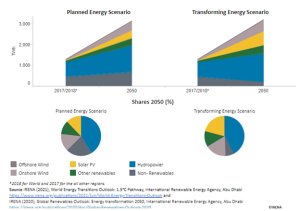
Source: International Renewable Energy Agency (IRENA), 2021[2]
Electricity Capacity by Region, Latin America
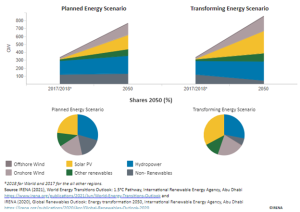
Source: International Renewable Energy Agency (IRENA), 2021[3]
Argentina
Argentina’s goal is to increase energy generation from renewables to reach 20 percent of the country’s demand by 2025. The government has awarded 244 projects that add more than 6,300 MW of installed capacity of renewable energies. The power generation from biogas increased 42.5%, biomass increased 30.4%, wind increased 28.4%, and solar increased 52.3%.[4]
Argentina launched the RenoAr program in 2016 to promote private renewable energy generation via auction. By the end of 2016, the program had resulted in 59 awarded projects with a combined capacity of 2.4 GW and combined investment of $3 billion. An additional round in 2017 brings the total projects awarded since the program began to 147 with 4.4 GW of renewable energy projects.[5] As of November 2023, 147 renewable energy projects are under way and 41 in planning totaling over $8 billion in direct investment and 6.2 GW of new-build capacity.[6]
According to data from the International Renewable Energy Agency (IRENA), Argentina’s electricity generation from renewable sources totaled 38,412 GWh in 2021.[7]
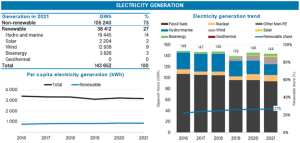 Source: International Renewable Energy Agency, 2022[7]
Source: International Renewable Energy Agency, 2022[7]
Brazil
Brazil led in new hydropower capacity in 2019, second in ethanol production, third in biodiesel production, and fourth in solar water heating capacity. Brazil is third in renewable power capacity behind the United States and China.[8] Brazil’s nuclear energy market is planning to more than quadruple its nuclear power generation by 2050. Brazil’s electricity market is the largest in Latin America and the 7th largest generation capacity in the world at 173.2 GW. In terms of Brazil’s energy mix, hydropower represents 63%, wind power is the second largest source of energy at 15 GW of installed capacity, and solar has tripled and reached 3 GW in installed capacity.[9]
According to data from IRENA, Brazil’s electricity generation from renewable sources totaled 522,935 GWh, 84% of Brazil’s electricity generation.[10]
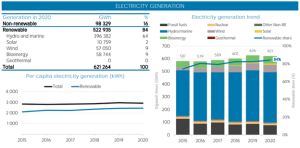
Source: International Renewable Energy Agency, 2022[8]
Brazil
Brazil’s investment in renewables was up 18.3% to $14.8 billion in 2022 which includes an increase of 23.7% for solar PV, and 14.5% increase in wind power investment. Brazil is also second of the top four countries in hydropower generation and added 300 MW in 2022.[9] Brazil’s nuclear energy market is planning to add eight additional nuclear power plants to add 10 GWh of production capacity. The projected investments for the nuclear energy sector total $50 billion over the next 30 years. Brazil’s electricity market is the largest in Latin America and the 7th largest generation capacity in the world at 181.6 GW in 2021. In terms of Brazil’s energy mix, hydropower represents 63%, wind power is the second largest source of energy at 15 GW of installed capacity and an additional 4.6 GW under construction, and solar has increased 40.9% in 2021 (utility scale) and 84% (distributed generation from solar).[10]
According to data from IRENA, Brazil’s electricity generation from renewable sources totaled 507,667 GWh, 77% of Brazil’s electricity generation.[11]
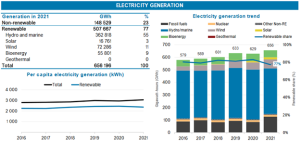
Source: International Renewable Energy Agency, 2022[12]
Chile
Chile seeks to be carbon neutral by 2050 and retire thermal power plants by 2040. The country’s top priorities include the promotion of energy storage and the Green Hydrogen Initiative which would make Chile a top exporter of hydrogen by 2050. The government has set 2030 as the target for having 70 percent of the country’s energy from renewable sources; the country is currently at 33%. As of December 2021, Chile has an installed power capacity of 30,862 MW, which is a 14.8% increase from the previous year. Of this total, 6,198 MW comes from solar, and 3,536 MW comes from wind.[13]
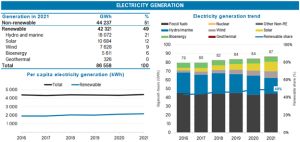
Source: International Renewable Energy Agency, 2022[14]
Colombia
Colombia has an electric power generation capacity of 17,726 MW as of 2021. Hydro accounts for 68%, coal and gas power plants account for 31% and wind accounts for 1%. Colombia plans to focus on solar and wind as evidenced by the work being done to strengthen La Guajira which is the largest source of wind energy in the country. The country also aims to generate 2.5GW of solar, wind, and biomass by 2022.[15]
According to data from IRENA, Colombia’s renewable energy electricity generation from renewable sources totaled 63,145 GWh in 2021.[16]
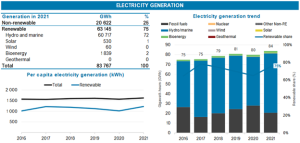
Source: International Renewable Energy Agency, 2022[17]
Costa Rica
Costa Rica generates less than 1% of its energy production from solar power, Hydro production is 79%, Wind 12%, and Geothermal 8%. Renewable energy in Costa Rica supplied about 98.53% of the energy output for the whole nation in 2018. Costa Rica’s high number per capita of rivers, dams, and volcanoes provides many renewable energy sources.[18] According to data from IRENA, Costa Rica’s renewable energy electricity generation from renewable sources totaled 12,656 GWh in 2021.[19]
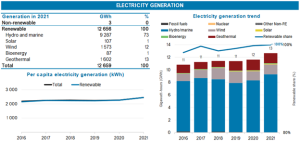
Source: International Renewable Energy Agency, 2022[20]
Paraguay
Paraguay’s energy mix is dominated by renewable energy sources, with hydropower accounting for 99.5% of installed power capacity in the country. Paraguay is dependent on the hydrological conditions of its rivers which feed the hydropower plants. By 2020, Paraguay’s renewables total installed capacity had reached 8,832 MW, of which 8,810 was hydropower and 22 from bioenergy. As of 2019, Paraguay’s energy supply came mainly from hydrologic (41%) and biomass (36.8%) resources.[21]
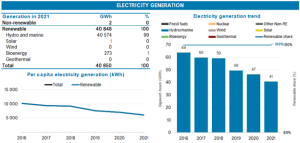
Source: International Renewable Energy Agency, 2022[22]
Updated by Erin George, December 2023

Comments are closed.